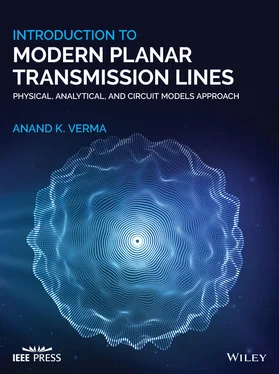In 1733, Fay proposed that electricity comes in two forms – vitreous and resinous, and on combination, they cancel each other. The flow of the two forms of electricity was explained by the two‐fluid model . During this time interval, around up to 1745, the electrical attraction and repulsion were explained using the flow of Gilbert's particle effluvium. In 1750, Benjamin Franklin proposed the one‐fluid model of electricity. The matter containing a very small quantity of electric fluid was treated as negatively charged, and the matter with excess electric fluid was treated positively charged. Thus, the negative charge was resinous electricity, and the positive charge was vitreous electricity. Now, the stage was ready for further theoretical and experimental investigations on electricity.
In the year 1773, Lagrange introduced the concept of the gravitational field , now called the scalar potential field , created by a mass. The gravitational force of Newton was conceived as working through the gravitational field . The scalar potential field has appeared as a mechanism to explain the gravitational force interaction between two masses. Thus, a mass located in the potential field, described by a function called the potential function , experiences the gravitational force. In 1777, Lagrange also introduced the divergence theorem for the gravitational field. The nomenclature potential field was introduced by Green in 1828. Subsequently, Gauss in 1840 called it “ potential . ” Laplace in 1782 showed that the potential function ϕ (x,y,z) satisfies the equation ∇ 2ϕ = 0. Now the equation is called Laplace's equation .
Following the Law of Gravitation, Coulomb postulated similar inverse square law, now called Coulomb's law , for the electrically charged bodies. He experimentally demonstrated the inverse square law for the charged bodies in 1785. Thus, the mathematical foundation of the EM‐theory was laid by Coulomb. The law was also applicable to magnetic objects. The interaction between charged bodies was described by the electric force. In the year 1812, Poisson extended the concept of potential function from the gravitation to electrostatics. Incorporating the charge distribution function ρ, he obtained the modified Laplace's equation, written in modern terminology, ∇ 2ϕ = −ρ/ε 0. This equation now called Poisson's equation is the key equation to describe the potential field due to the charge distribution. In the same year, Gauss rediscovered the divergence theorem originally discovered by Lagrange for the gravitational field.
In the year 1828, Green coined the nomenclature – the potential function , for the function of Lagrange and modern concept of the scalar potential field came into existence. Green also showed an important relation between the surface and volume integrals, now known as Green's Theorem . Green applied his method to the static magnetic field also. Green also introduced a method to solve the 3D inhomogeneous Poisson partial differential equation where the considered source is a point charge. The point charge is described by the Dirac's delta function . The solution of the Poisson's partial differential equation, using Dirac's delta function, is now called Green's function . Neumann (1832–1925) extended the Green's function method to solve the 2D potential problem and obtained the eigenfunction expansion of 2D Green's function [J.1–J.5, B.2, B.7].
Magnetic Effect of Current
So far, we have paid attention to the electrostatics. At this stage, Leiden jar was the only source of static electricity. A source for the continuous electric current was not available. Volta in 1799 invented the voltaic pile, i.e. a chemical battery , and the first time a continuous source of electric current came into existence. On April 21, 1820, it led to the discovery of the magnetic effect of current flowing in a wire. The electric current became the source of the magnetic field, encircling the current‐carrying wire. The magnetic effect of current was discovered by Orsted (Oersted). In the same year, Ampere showed that the co‐directional parallel currents flowing in two wires attract each other, and the counter‐currents repel each other. It was a very significant discovery, i.e. creation of the attractive and repulsive magnetic forces without any physical magnet. It firmly established the relation between electricity and magnetism. Ampere further developed an equation, presently called Ampere's Circuital Law , to connect the current flowing in a wire to the magnetic field around it and developed the right‐hand rule. He called the new field of electricity Electrodynamics and Maxwell recognized him as the Father of Electrodynamics . Ampere further modeled the natural magnetic materials as the materials composed of perpetual tiny circulating electric currents. He demonstrated the validity of his concept using the current‐carrying conductor in the helical form called a solenoid . The solenoid worked like an artificial bar magnet. In the year 1820 itself, Biot–Savart obtained the equation using the line integral to compute the magnetic field at a position in the space due to the current flowing in a wire [J.2, B.6, B.7].
The voltaic pile helped the discovery of the magnetic effect of current; however, surprisingly the relation between the current flowing in resistance and voltage across it, known as the Ohm's law , remained undiscovered. The primary reason was the unstable voltage supplied by the voltaic pile. The discovery of thermoelectricity by Seebeck in 1822 provided a constant voltage source to supply continuous electric current. Using the thermo‐piles in the year 1826, Ohm obtained a simple but powerful relation among voltage, current, and resistance. It was the beginning of the Electric Circuit Theory . However, only in 1850 Kirchhoff published his two circuital laws and opened the path for the development of the Network Theory . Kirchhoff also showed that Ohm's electroscopic force (voltage) and classical potential of Lagrange, Laplace, and Poisson are identical. Interestingly, Ohm's law could be viewed as a symbol of the International Scientific unity relating to Italy (Volta), Germany (Ohm), and France (Ampere). Based on the magnetic effect of current, in the same year, Johann Christian Poggendorff invented the galvanometer to detect the current in a wire. Kelvin improved its sensitivity by designing the mirror galvanometer in 1858 [B.1, B.6, B.7].
Electric Effect of the Time‐Varying Magnetic Field
On knowing the magnetic effect created by an electric current, Faraday argued that the magnetic field can also produce the electric effect. After some attempts, he realized that such an effect can't be produced by the stationary magnet. In 1831, he could generate the electric potential ( electromotive force ) and electric current by the time‐varying magnetic field of a moving magnet. The phenomenon is called the induction effect . The voltage induction effect demonstrated that electricity could be generated by a purely mechanical process, converting the mechanical energy into electrical energy via the medium of the moving magnetic field. The first DC generator was demonstrated by Faraday himself, and next year French instrument maker Hippolyte Pixii built the first A.C. generator inaugurating the Electrical Age. Now, the electricity was ready to accelerate the growth of human civilization at an unprecedented rate [B.6, B.7].
Читать дальше












